Warm Up:
Master Tony Wong's Silkreeling Simplified
All classes by Master Tony Wong include silkreeling exercises. The complete set takes 1 hour. Master Wong also has a shortened silkreeling form, but here is an unofficial way to do it with only one exercise per body joint.
This website is from Kevin Wacknov, with form lesson videos from Marlon Bishop. Both Kevin and Marlon are students of Grandmaster Tony Wong.
Learning Some Tai Chi Basics Sitting
Most tai chi is done standing up, but you can learn some basics about relaxing the body, yin and yang, and the five elements, and meditation while doing sitting exercises.
Standing Meditation
Standing meditation is very important for aligning the body posture and preparing for Tai Chi movement.
You can stand in this posture for 1-20 minutes and get great benefits. Start gradually and build up time and regularity of practice.
The video below describes Master Tony Wong's method to get into the standing meditation posture.
Another way to do it was described by Grandmaster Cai Song Fang (one of Tony's teachers), who said to align three vertical points and then focus awareness in the lower abdomen:
Align these points:
- Midpoint of line joining arches in feet (on the ground between the Bubbling Well acupunture points.)
- Perineum (point between anus and genitals, called the Hui Yin acupuncture point.)
- Top of the Head (acupuncture point: Bai Hui.)
Then keep your attention for a long period of time at your dan tian (2 inches behind belly button).
Other Videos
Eight Brocades QiGong (BaDuanJin)
Muscle and Tendon Changing from Bad to Good (Yi Jin Jing Exercise)
Tai Chi Ball exercises simplified
Push-hands, Microcosmic Orbit, Tai Chi drills
Protecting the Knees
Storing and Releasing with the Leg Muscles
Using a Mantra to Clean Up Your Tai Chi
Help for Emotionally Sensitive People
Chen Tai Chi
Laojia Yilu
(Old Family First Form)
Mirror Image Training Videos —
So when you follow the screen,
your left and right are correct.
(These are more gentle Tai Chi videos.)
Demonstrated by Kevin Wacknov,
student of Master Anthony (Tony) Wong
(click Arrow Circle to start that video lesson.)
PART I
- Taiji Beginning Posture
- Jin Gang Pounds with the Pestle
- Grab and Tuck in the Robe
- Six Sealing and Four Closing
- Dantian Change
- Jin Gang Pounds with the Pestle
- The White Goose Displays the Wings
- Oblique Posture
- Embrace the Knee
- Paced (Awkward) Steps
- Oblique Posture
- Embrace the Knee
- Paced (Awkward) Steps
- Covering-the-Hand Forearm Fist
- Jin Gang Pounds with the Pestle
- Diagonal Body-Stroke Fist
- Teal Dragon Emerges from Water
- Push with Both Hands
PART II
- Fist Presented Under the Elbow
- Reverse with Spiraling Forearms
- White Goose Displays the Wings
- Oblique Posture
- Flash through the Back
- Covering-the-Hand Forearm Fist
- Six Sealing and Four Closing
- Dantian Change
- Maneuver the Hands
- Feel Out the Tall Horse
- Thrust with the Right Foot
- Thrust with the Left Foot
- Kick with the Left Heel
- Paced (Awkward) Steps
- Immortal's Grappling Grip
- Kick with Two Feet Up
- Protecting-the-Heart Fist
- Whirlwind Kick
- Kick with the Right Heel
- Covering-the-Hand Forearm Fist
- Small Catching and Striking
- Embrace Head and Push Mountain
- Six Sealing and Four Closing
- Dantian Change
PART III
- Forward Trick
- Backward Trick
- Part the Wild Horse's Mane
- Six Sealing and Four Closing
- Dantian Change
- Jade Lady Works the Shuttle
- Grab and Tuck in the Robe
- Six Sealing and Four Closing
- Dantian Change
- Maneuver the Hands (Cloud Hands)
- Swing the Leg
- Drop and Split
- Golden Rooster Stands on One Leg
- Reverse with Spiraling Forearms
- The White Goose Displays the Wings
- Oblique Posture
- Flash through the Back
- Covering-the-Hand Forearm Fist
- Six Sealing and Four Closing
- Dantian Change
- Maneuver the Hands (Cloud Hands)
- Feel out the Tall Horse
- Cross the Foot
- Pointing-to-the-Groin Punch
- Giant Monkeys Search for Fruit
- Dantian Change
- Ground-Hacking Dragon
- Step Forward to Form the Seven Stars
- Step Backward to Cross the Forearm
- Swing the Leg
- Head-On Cannon
- Jin Gang Pounds with the Pestle
- Closing Posture
- Kevin Entire Form
- Master Tony Wong Entire Form
Chen Tai Chi
Laojia Yilu
(Old Family First Form)
NOT Mirror Image Training Videos —
So your left and right are reverse
of person facing you on the screen.
(These are more aggressive Tai Chi videos.)
Demonstrated by Marlon Bishop,
student of Master Anthony (Tony) Wong
(click Arrow Circle to start that video lesson.)
PART I
- Taiji Beginning Posture
- Jin Gang Pounds with the Pestle
- Grab and Tuck in the Robe
- Six Sealing and Four Closing
- Dantian Change
- Dantian Change (hands)
- Jin Gang Pounds with the Pestle
- The White Goose Displays the Wings
- Oblique Posture
- Embrace the Knee
- Paced (Awkward) Steps
- Oblique Posture
- Embrace the Knee
- Paced (Awkward) Steps
- Covering-the-Hand Forearm Fist
PART II
- Jin Gang Pounds with the Pestle
- Diagonal Body-Stroke Fist
- Teal Dragon Emerges from Water
- Push with Both Hands
- Fist Presented Under the Elbow
- Reverse with Spiraling Forearms
- White Goose Displays the Wings
- Oblique Posture
- Flash through the Back
- Covering-the-Hand Forearm Fist
- Six Sealing and Four Closing
- Dantian Change
- Maneuver the Hands
- Feel Out the Tall Horse
- Thrust with the Right Foot
- Thrust with the Left Foot
- Kick with the Left Heel
- Paced (Awkward) Steps
- Immortal's Grappling Grip
- Kick with Two Feet Up
- Protecting-the-Heart Fist
- Whirlwind Kick
- Kick with the Right Heel
- Covering-the-Hand Forearm Fist
- Small Catching and Striking
- Embrace the Head and Push the Mountain
- Six Sealing and Four Closing
- Dantian Change
PART III
- Forward Trick
- Backward Trick
- Part the Wild Horse's Mane
- Six Sealing and Four Closing
- Dantian Change
- Jade Lady Works the Shuttle
- Grab and Tuck in the Robe
- Six Sealing and Four Closing
- Dantian Change
- Maneuver the Hands (Cloud Hands)
- Swing the Leg
- Drop and Split
- Golden Rooster Stands on One Leg
- Reverse with Spiraling Forearms
- The White Goose Displays the Wings
- Oblique Posture
- Flash through the Back
- Covering-the-Hand Forearm Fist
- Six Sealing and Four Closing
- Dantian Change
- Maneuver the Hands (Cloud Hands)
- Feel out the Tall Horse
- Cross the Foot
- Pointing-to-the-Groin Punch
- Giant Monkeys Search for Fruit
- Dantian Change
- Ground-Hacking Dragon
- Step Forward to Form the Seven Stars
- Step Backward to Cross the Forearm
- Swing the Leg
- Head-On Cannon
- Jin Gang Pounds with the Pestle
- Closing Posture
- Marlon Entire Form
- Master Tony Wong Entire Form
Notes
Tai Chi Points to Remember
(Taught by Master Anthony Wong)

- When doing the silkreeling drills, focus on the joints closing, and then opening with the body expanding.
- Take this method into your tai chi form postures.
- Don't loose your rooted feet feeling. Also, extend the spine more straight, and relax it, and sink the energy down.
- When punching, don't let the rear qua and knee turn inward. Keep the qua open when turning the waist to shoot the fist forward.
- The whole body works as a unit.
- Sink into the kua (muscle/tendon band around upper leg near hip joint) at the LEFT leg and the RIGHT leg.
- Some basic energies to include in your form are spiraling, sinking-then-issuing, and closing-then-opening.
- When the leg goes down, you feel the earth return a force back up your leg.
- Try to feel the back.
- Start all rotations with the dan tian.
- Do some advanced planning positioning the feet at the end of one posture to be ready for the beginning of the next posture.
Quick QiGong Exercises Taught by Professor Qu Limin during the June 25-26, 2016 Yi Jin Jing Workshop in the South Bay
| NAME OF MINI-EXERCISE | INSTRUCTIONS | BENEFITS |
|---|---|---|
| Move the Water in the Shoulder Wells |
|
good to keep chi healthy after age 50 |
| Empty Liver Anger from the Armpits |
|
good for frustration in relationships |
| Empty Spleen Stagnation from Hips (Kua) |
|
good for helping with diabetes |
| Roll Fingertips of Tiger Claw Hands on Table |
|
good for overall strength and to increase your intelligence |
| Cool the Heart Fire with Kidney Water |
|
good to calm yourself down |
| Help Digest a Big Meal |
|
good after a big meal |
Basic Chinese Medicine Ideas taught by Professor Qu Limin
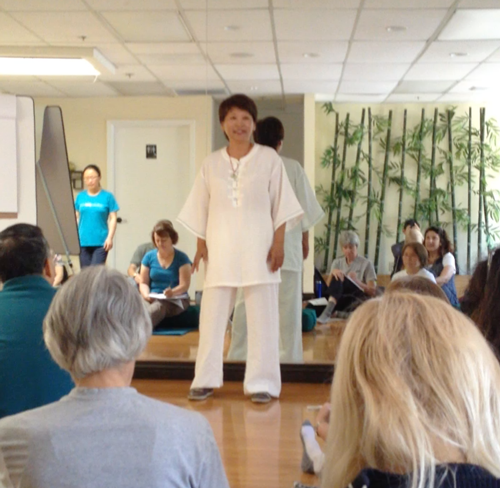
The Yi Jin Jing, Classic Book and Exercise of Muscle-Tendon Changing
Written by Zen Buddhist Patriarch Da Mo (Bodhidharma) after meditation in front of a cliff wall for 9 consecutive years in 500 AD and thinking about how to get the meditators of his day in shape after focusing only on their Minds (Chi), not their Bodies (Blood, or Liver fluid).
Professor Qu Limin is the source of most of these notes. She gave a workshop June 25-26 in San Jose, CA and Sunnyvale, CA through Tai Chi Master Tony Wong's support.
Why is the YJJ the only Classic Text of QiGong? Because it starts 50% Yang and 50% Yin, leading with the thumb side of the hand, not the back or front of the hand.
| Notes | Image |
|---|---|
TCM Basic Acu-PointsThe Most Yang Point (Ba Gua, "Bah-Guey") is where 100 yang lines (all yang paths of the body) meet. There is another such point, at the big bone protruding at the vertebra at the base of the neck. The Bubbling Well points are where the Human Essence begins to emerge from the Earth's energy. The Most Yin Point (Hui Yin, Perineum, the point between anus and genitals) is the starting and ending point for all energy in all QiGong exercises, says Professor Limin Qu. The Shoulder Well points (where the Clavicle is felt between the shoulder muscles) on either side is the most important Health Maintenance Point in gigong. The basic exercise for "moving the stuck (tight) energy in the Shoulder Wells" is slow shoulder rotation exercise. On each side of the body, the Bubbling Well is where our Personal Energy starts, and the Shoulder Well is the peak of our Personal Energy. Professor Qu Limin says, "If you align the Bubbling Well Points with the Shoulder Well Points of both sides, and the Most Yin Point with the Most Yang Point while standing, this is better than doing the exercise form 100 times." |
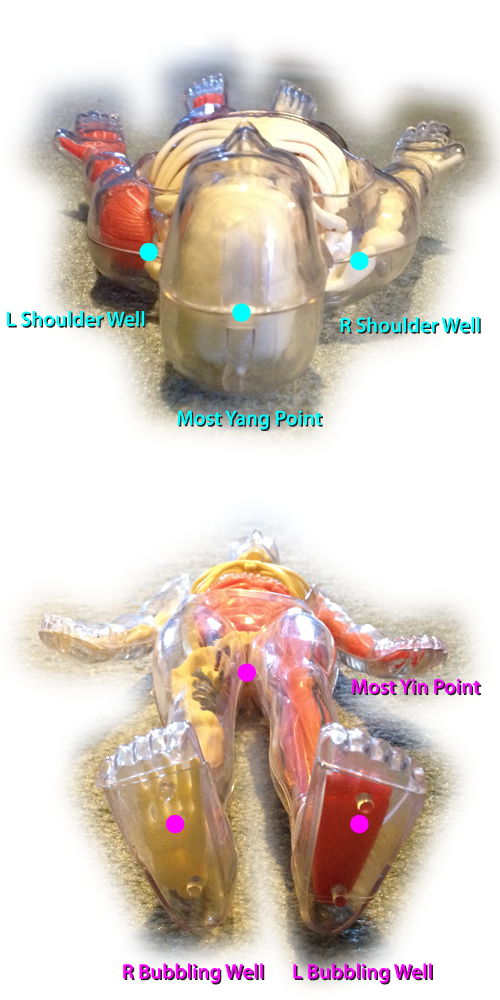 |
TCM Main Channels (Meridians)The Governor Meridian runs along the skin from the Perineum up the spine, over the head through the Most Yang Point, and down to the hard palate just behind the front teeth. The Conception Meridian runs from the Perineum along the front of the body to the tip of the tongue. When the tongue curls slightly at the tip and touches behind the front upper teeth, the circuit is completed and Qi and Blood flow well. When talking the circuit is broken. Hold a slight tension in the Perineum to keep the essences from "dripping out" the bottom of the loop. The Qi and Blood can circulate in either direction, and to force it to change in either direction is thought to be unnatural. This energy loop is called the Microcosmic Orbit, because Qi and Blood are thought to be like the Sun and Moon moving relative to the earth, and the Human Body is like a universe in miniature. This is why the 9 Palaces Map is also used for Feng Shui, enabling practitioners to adjust living spaces according to the same universal principles which govern the human body and its organs. |
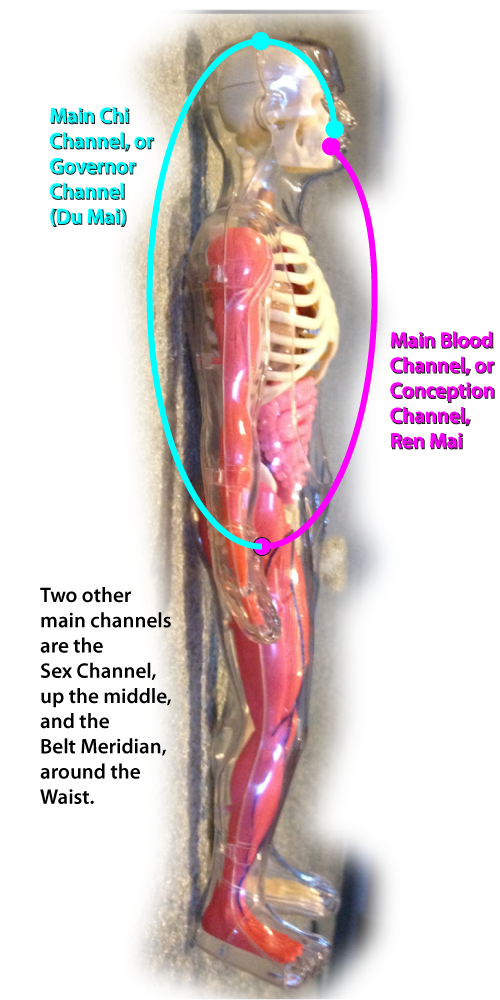 |
TCM Chi Flow Side ViewIn reverse direction, cooling occurs. This can be done naturally, as when the body gets ready for sleep, or deliberately, as a meditative exercise. |
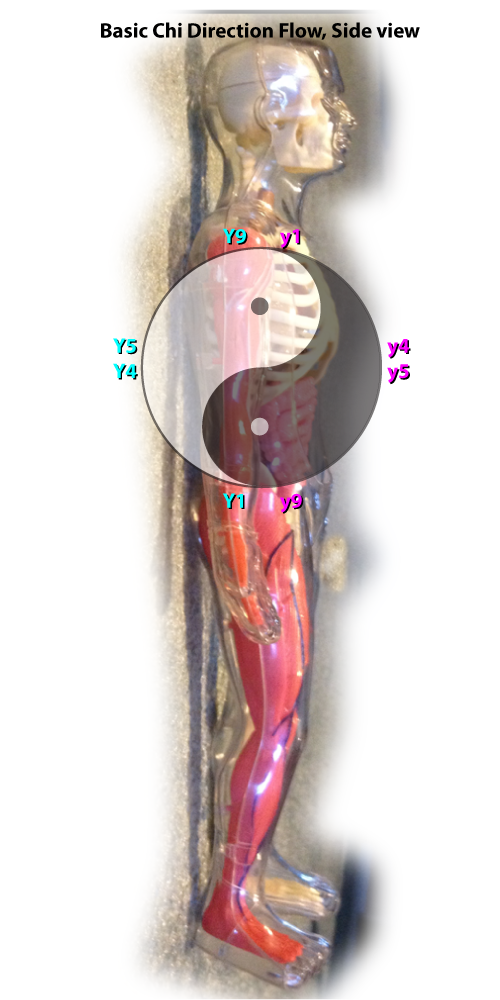 |
TCM Eight Vessels to EmptyEnergy stuck in these vessels (4 left, 4 right) cause health problems. Actively release them before and while doing the Tai Chi or QiGong forms. |
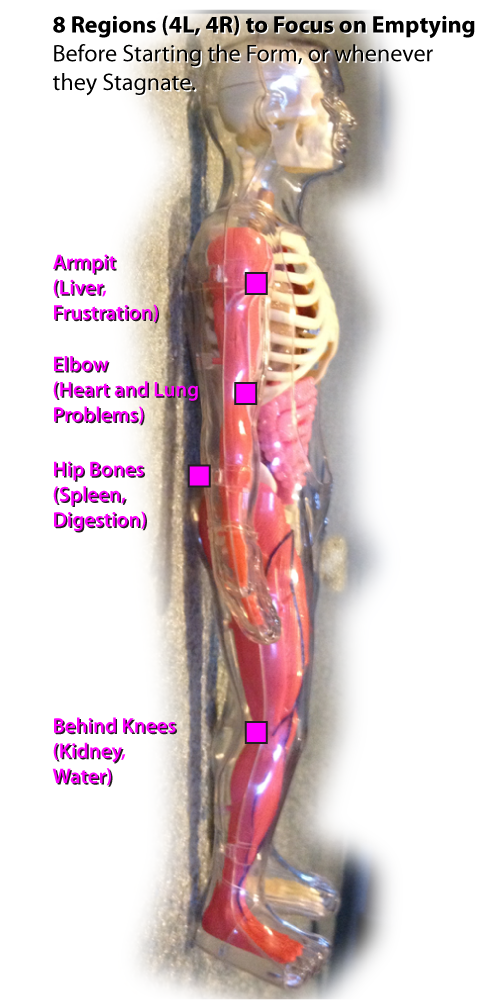 |
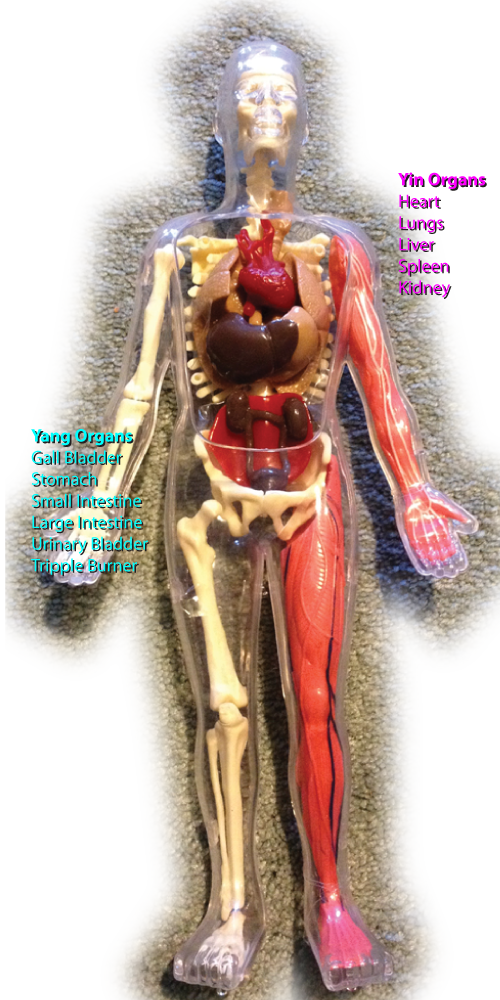
TCM Organs
Yin Organs are Female, protected indoors (Rib Cage), and collect the money (Nutrients)
Yang Organs are Male, work outdoors (not in rib cage), and are always moving.
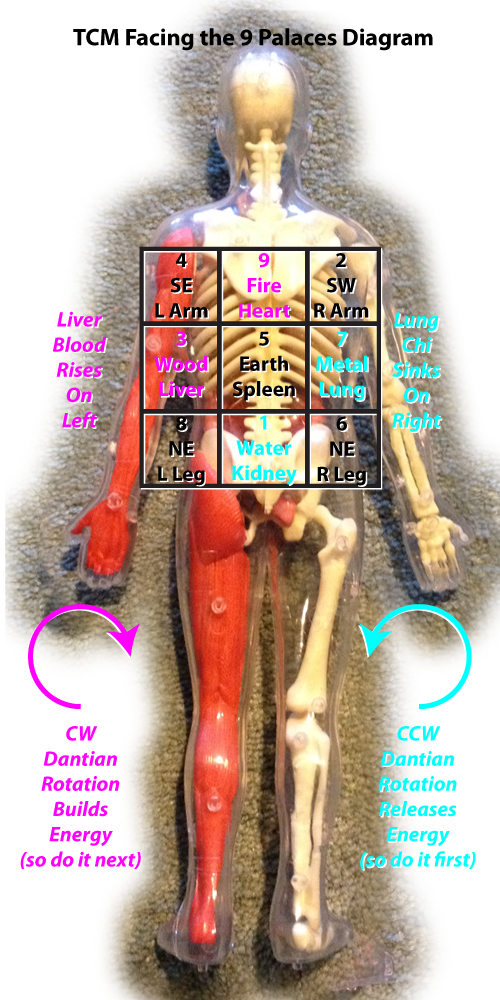
TCM Body Grid (9 Palaces Map)
Western European Anatomy studies show the Liver on the Right side of the abdomen under the ribs; Chinese Medicine feels the Liver Blood to be rising on the Left side of the body.
Clockwise DanTian rotations starting from the Water region build energy according to the 5 Element Creation Cycle: Water -> Wood -> Fire -> Earth -> Metal -> Water...
Therefore, Counterclockwise DanTian rotations starting from the Water location (below navel) break down or release energy since you are moving your internal energy with your hands against the 5 Element Creation Cycle: Water -> Metal (Lung) -> Fire (Heart) -> Wood (Liver) -> Water (Kidney or Bladder).
Empty yourself before refilling, of course. When your hands are positioned below your navel and you're starting dantian rotations, go to the right first.
Men are more Qi dominant, so they encourage Yin-Blood-Liver-Left Hand covering the Right Hand when doing dan tian rotations; Woman are more Blood dominant, so they encourage Yang-Qi-Lung-Reft Hand covering the Left Hand when doing dan tian rotations.
Since Blood moves slower than Chi, start your qigong or tai chi form by moving the left leg (Liver-Blood side) first to give it a head start. Then activate the Chi by turning the big toes in toward each other imperceptibly, which opens the lumbar back very slightly. Now your Yin-Yang Chi Engine is ready to go!
Start the form very deliberately, and End the form very deliberately.
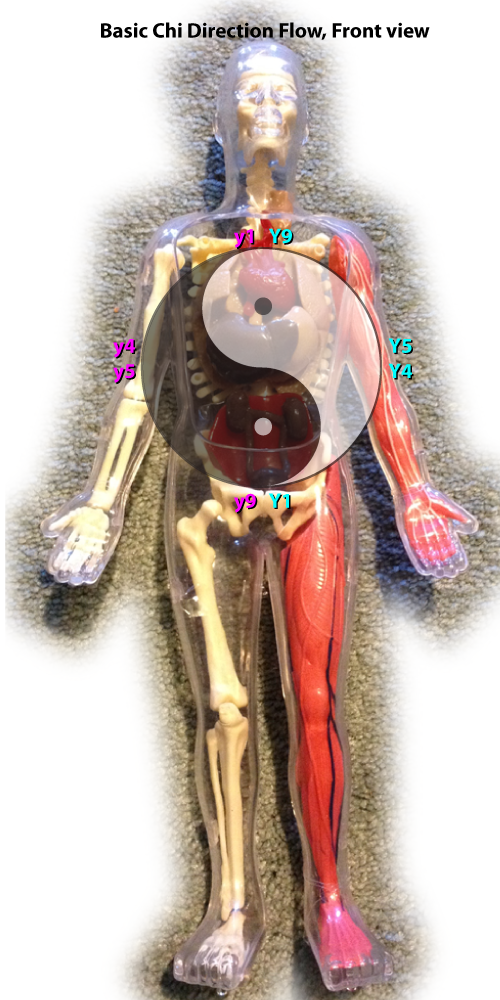
TCM Basic Chi Flow Direction, Front View
In reverse direction, energy is 'destroyed,' or released.
The maximum potency and minimum space of yang is at Y1, like in a baby boy.
The minium potency and maximum space of yang is at Y9, like an old man.
The most stable yang energy, at Y4, is said to be 4x9=36 year old male, said Dr. Qu Limin.
The male reproductive energy is best at 4x8=32 years, according to the Yellow Emperor's Internal Medicine Classic.
At Y5 (40 years old), the male energy is already deteriorating, says Dr. Qu Limin.
For women, the formula is similar, but the best yin energy is at Y4, (? years old). The Yellow Emperor said women reproduce best at 4x7=28 years old.

TCM 6 Healing Sounds
Form your lips and throat into the usual shape to say the sound out loud, but make the sound only in your head to keep the energy inside.
Make the internal sound and do the corresponding exercise the number of times indicated for that organ's position in the 9 Palaces Table.
The Heart Sound (He) can be made with decreasing pitch in your inner voice as you cycle energy Down, Forward, Up, Back, and Down to "pour Kidney water over the Heart fire to cool it."